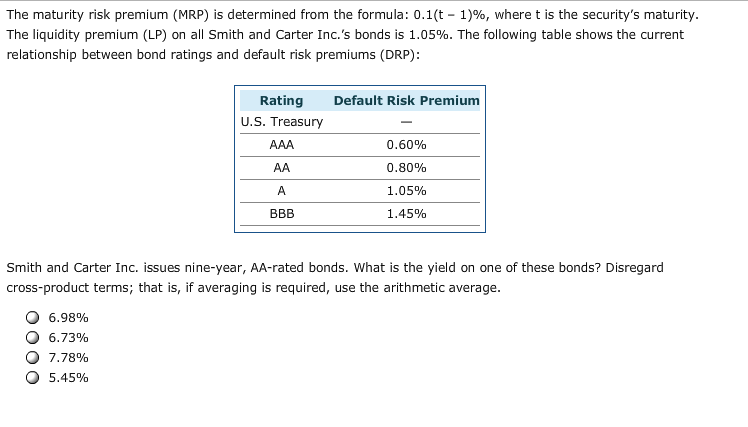
5-6 Maturity Risk Premium The real risk-free rate is 3 and inflation is expected to be 3 for the next 2. IP2 332 Inflation Rate.

The formula for market risk premium is derived by deducting the risk-free rate of return Risk-free Rate Of Return A risk-free rate is the minimum rate of return expected on investment with zero risks by the investor.
Maturity risk premium formula. A maturity risk premium is the amount of extra return youll see on your investment by purchasing a bond with a longer maturity date. Maturity risk premiums are designed to. Hence we must consider the maturity of investment for which we are determining the required return and add a maturity risk premium appropriate for the given maturity.
The following formula gives a general framework for estimation of maturity premium. Maturity Risk Premium. A maturity risk premium is the amount of extra return youll see on your investment by purchasing a bond with a longer maturity date.
Maturity risk premiums are designed to. The general formula is r r IP MRP. R 2 62 Security Yield for 2 years.
R 3 Risk Free Rate. IP2 332 Inflation Rate. Maturity Risk Premium for 2 years.
R 2 r IP2 MRP2 62 3 3 MRP2 MRP2 02. Market Risk Premium Expected rate of returns Risk free rate. Market risk Premium 95 8.
Market Risk Premium 15. So from the above example one can see investors in Reliance industries will be getting risk premium of 15 above the government bond rate. Significance and Use of Risk Premium Formula.
Subtract the 10-year treasury security yield from the one-year treasury security yield to get the maturity risk premium. For example as of the time of publication the one-month treasury yield was 002. The 10-year treasury yield was 215.
Subtracting one from the other has a result of 213. Formula to Calculate Risk Premium. The risk premium is calculated by subtracting the return on risk-free investment from the return on investment.
Risk Premium formula helps to get a rough estimate of expected returns on a relatively risky investment as compared to that earned on a risk-free investment. Risk Premium Formula. The following formula is used to calculate a risk premium.
Where Ra is the return on a risk-free asset. RF is the return on actual investment. A risk premium is the difference in returns between a risk free asset and another asset class or individual asset.
How to calculate Risk Premium. The formula for risk premium sometimes referred to as default risk premium is the return on an investment minus the return that would be earned on a risk free investment. The risk premium is the amount that an investor would like to earn for the risk involved with a particular investment.
The US treasury bill T-bill is generally used as the. Calculating the default risk premium Basically to calculate a bonds default risk premium you need to take its total annual percentage yield APY and subtract all of the other interest rate. Maturity risk premium the real risk free rate is 3.
5-6 Maturity Risk Premium The real risk-free rate is 3 and inflation is expected to be 3 for the next 2. The formula for market risk premium is derived by deducting the risk-free rate of return Risk-free Rate Of Return A risk-free rate is the minimum rate of return expected on investment with zero risks by the investor. It is the government bonds of well-developed countries either US treasury bonds or German government bonds.
About Press Copyright Contact us Creators Advertise Developers Terms Privacy Policy Safety How YouTube works Test new features Press Copyright Contact us Creators. The real risk-free rate is r 30 the inflation premium for 5-year bonds is IP 175 the liquidity premium for Koys bonds is LP 075 versus zero for T-bonds and the maturity risk premium for all bonds is found with the formula MRP t - 1 01 where t number of years to maturity. What is the default risk premium DRP on Koys.
If inflation stands at 05 then the real risk-free rate would be 15. The risk-free rate of 2 minus 05 inflation equals 15. The calculated value of the inflation risk premium on all 5 year bonds is 14.
The maturity risk premium on all 5 year bonds is given by. T - 1. Maturity Risk Premium 5-10104 5-year T Bonds Yield Risk free real return inflation premium maturity premium 515 3 175 04.
Default risk premium can be determined using the following formula. Default Risk Premium Yield CB - Yield TB - LRP. Where Yield CB is the yield on corporate bond and Yield TB is the yield on treasury bond of comparable maturity and LRP is the liquidity risk premium if any.
Yield on 10-year US Treasury bond is 42 and yield on a AA-rated corporate bond with 10 years to maturity is 6. A maturity risk premium is defined as the process by which investors demand a lower price and consequently a higher yield for bonds with extended maturation periods. Didnt Read A maturity risk premium is a reduced price and subsequent increased yield on a bond that has an extended maturation period.
In cell C3 you might add the following formula. The result is the risk premium. Using the earlier examples assuming that the risk-free rate using current yields for TIPs is 03 and.